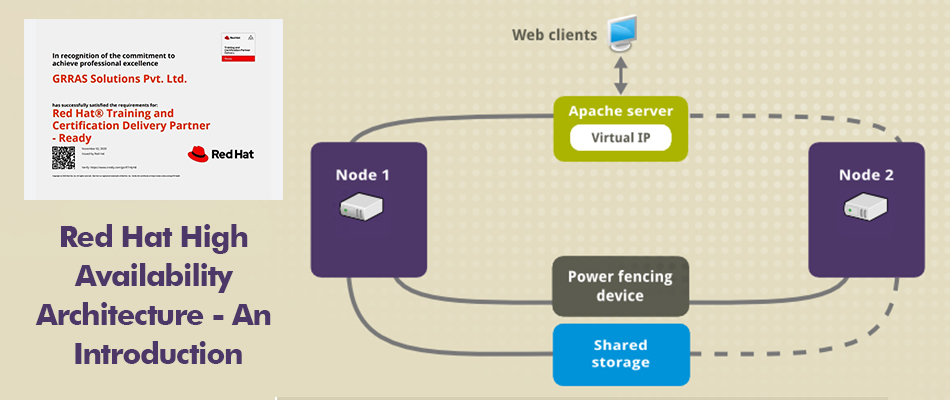Red Hat is a name that is highly popular amongst tech professionals. Organizations from all domains have found use of this technology. As the demand for Red Hat professionals rise, the demand for a competitive training and certification course rises too.
The knowledge span in this field is huge. As the branches that stem out are multiple, it is not possible for one person to have all the knowledge. If you have decided to become a part of this field, then you must have a lot of questions on your mind.
In this blog today, we are going to take you through a journey about Red Hat High Availability architecture. It is a lot of things and does a lot as well. Of course, you will need the aid of a training and certification program to fully become an expert in the field. This blog is only an introduction to what you can expect.
Let us decode the entire conundrum around Red Hat high availability now. You will be getting dips into a lot of its uses and why it has become such an integral aspect. Let us begin with a basic introduction to help you get a better footing.
High Availability – A Brief
When we talk about high availability, there are a lot of things you need to learn. For starters, high availability brings together two concepts for determining whether an IT system is at par with its operational performance level or not. This means that a server or service is accessible as well as available almost always without any downtime. It also aims at finding that whether a server or service performs as per the reasonable expectations for a particular time period.
High availability is way more than just about hitting an uptime SLA (service level agreement). It is also not just about meeting the expectations set between a client and a service provider. In fact, it is more about truly reliable, well-functioning, and resilient systems.
What is a High Availability Cluster?
Now that we have discussed about high availability, let us take a step further to discuss high availability (HA) clusters.
High availability clusters can be referred to as groups of physical machines or hosts. These come together to act as a single system to provide continuous availability.
Such clusters are mostly used for mission critical applications such as transaction processing systems, eCommerce websites, and databases. They also come in handy for failover, backup, and load balancing purposes.
All the hosts in a cluster need to have access to the same shared storage to be able to successfully configure a high availability cluster. In the event of a failure, a VM or virtual machine on one host failovers to another host, without rendering any downtime.
A high availability cluster can have multiple nodes, ranging from two to dozens at a time. However, a storage administrator must know that adding too many hosts and virtual machines to a single high availability cluster may lead to a difficult load balancing.
How does High Availability Infrastructure Work?
The job of a high availability infrastructure is simple. It detects and then eliminates single points of failure that hold the potential to contribute to heightened system downtime, leading to delays in the organization reaching its performance goals. It should be noted that various single points of failure may exist in a complex system.
There are multiple types of failures that may occur in a complex, modern an IT infrastructure. It is the organization that needs to take them all into account. These include service failures, software failures, inaccessible latency and networking, external failures (such as power outage), and hardware failures.
Every organization first and foremost needs to is to determine the most integral outcomes it wishes to see. These outcomes can be based on –
- Workload
- Critical applications
- Core services
- Compliance or regulatory requirements
- Operational priorities
- Performance benchmarks
How does High Availability Cluster Work?
A high availability server cluster is a group of servers supporting services o applications that need to work reliably but with minimal downtime.
In the case of high availability architectures, they employ redundant software that performs similar functions that are installed on multiple machines. Thus, each of these have the potential to be used as a backup in case of a component failure. Thus, if this clustering is not there and an application fails, the service will be unavailable unless repaired.
Such a situation is prevented by a high availability architecture by using this process –
- Detect failure
- Perform failover of the app to a different redundant host
- Restart or repair the failed server without any manual intervention
What are High Availability Cluster Concepts?
There are three main high availability cluster concepts. Their knowledge will be better imparted in a training and certification program. However, we have attempted to give you a brief about the same to help you kickstart your career.
Active/ Active Cluster
When a cluster has an active/ active design, it means that it has two or more nodes having the same configuration. Each of these is directly accessible by clients.
In this cluster, if a node fails, clients can automatically connect with another node and work with it, given that it has enough resources. Once the first node is replaced or restored, clients are once again split between the original nodes.
Such a cluster aids in effectively achieving node-network balance. The load balancer shifts traffic to nodes having the capability to handle that traffic better by employing predefined algorithms.
Active/ Passive Cluster
In an active/ passive model, a single node serves the client initially. It keeps on working alone as long as it does not fail for some reason. Once that happens, the new as well as the existing sessions get transferred to an inactive or a backup node.
The best way go about this type of cluster is to add one additional redundant component for every type of resource. This helps in assuring that you always have sufficient resources for your existing demand, while also covering potential failure.
Shared-Nothing vs Shared-Disk Cluster
One of the core principles of distributed computing states that it is important to avoid single points of failure. Tus, resources should either be replaceable or actively replicated, as well as no singular factor should be able to disrupt the whole service in case it goes down.
If multiple nodes are dependent on a single database server. Irrespective of the number of nodes, one node’s failure will not influence the persistent state of others. However, the entire cluster will be rendered useless if the database fails. Hence, the database can be referred to as the single point of failure here. This is shared disk cluster.
On the contrary, imagine every node having its own database. Of course, they have to synchronized for transactional consistency. But the plus here is that one nodes’ failure will not have an adverse effect on the entire cluster. This is shared nothing cluster.
What are the Components of a High Availability Architecture?
Every high availability cluster architecture comprises of four key components. It is essential to be aware of these components. As a professional in this field, you must know about these components.
With the right knowledge, you will be able to land the best job profiles in leading organizations. Here is a brief about each of the four key components.
Load Balancing
It is important for a high availability system to have an intricately design, pre-engineered mechanism to aid with load balancing. This helps in distributing client requests between the various cluster nodes. The duty of the load balancing mechanism is to state the exact failover process in the case of a node failure.
Geographical Diversity
We are living in a highly advanced IT environment. With the advancing cloud technology, it has become increasingly important to dispense high availability clusters throughout geographical locations. Thus, ensuring the application or the service to be resilient to disaster affecting only one physical location as it can now failover to a node available in another physical location.
Data Scalability
It is important for a high availability system to take scalability of disk storage units or databases into account. There are two options for data scalability that are commonly chosen. These two are –
- Making sure individual app instance are able to maintain their own data storage
- Making use of a centralized database to make it highly available with partitioning or replication
Backup and Recovery
High availability architectures are not free of the fear of errors holding the potential to bring an entire service down. In such an event, it is integral for the system to have a backup and recovery strategy in place. This will ensure the restoration of the entire system within a predefined RTO or recovery time objective.
Conclusion
With the right Red Hat training and certification course, you will be able to become an expert in the field. Get trained under experts of the fields to get the job of your dreams now. Enroll with Grras Solutions now!






